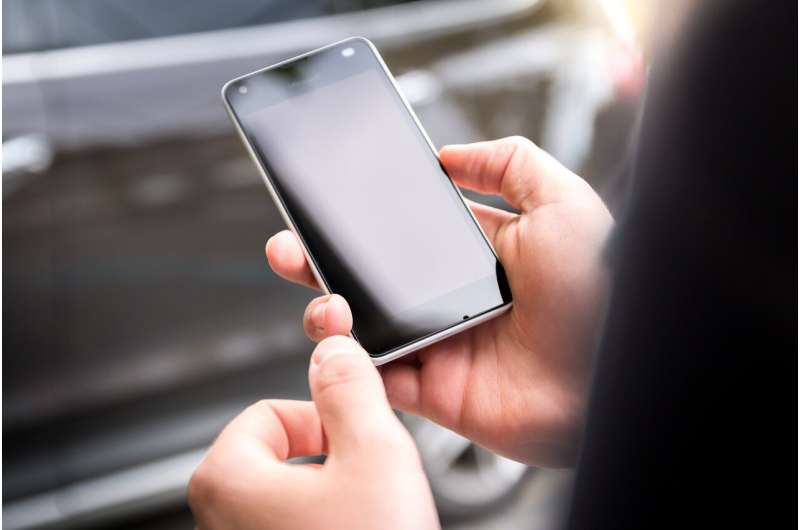This article has been reviewed according to Science X's editorial process and policies. Editors have highlighted the following attributes while ensuring the content's credibility:
fact-checked
trusted source
proofread
Smartphone app may help identify stroke symptoms as they occur

A new smartphone application called FAST.AI may help people who are having a stroke or their family and caregivers recognize common stroke symptoms in real time, prompting them to quickly call 9-1-1, according to preliminary research to be presented at the American Stroke Association's International Stroke Conference 2023. The meeting, to be held in person in Dallas and virtually Feb. 8-10, 2023, is a world premier meeting for researchers and clinicians dedicated to the science of stroke and brain health.
According to the American Heart Association, stroke is the No. 5 cause of death and a leading cause of disability in the U.S. About 85% of all strokes in the U.S. are ischemic strokes, which are caused by a blood clot in a blood vessel that blocks the flow of blood to the brain.
FAST.AI is a fully automated smartphone application for detection of severe stroke using machine learning algorithms to recognize facial asymmetry (drooping of the muscles in the face), arm weakness and speech changes—all common stroke symptoms. This study is ongoing, and the mobile application is still in development and not available to the public.
The smartphone application uses a facial video of the patient to examine 68 facial landmark points; sensors that measure arm movement and orientation; and voice recordings detect speech changes. Information from each test was sent to a database server for analysis.
Researchers validated FAST.AI's performance by testing nearly 270 patients with a diagnosis of acute stroke (41% women; average age of 71 years) within 72 hours of hospital admission at four major metropolitan stroke centers in Bulgaria (St. Anna University Hospital in Sofia; University Hospital Haskovo in Haskovo; University Hospital Pulmed in Plovdiv; and University Hospital "Prof. Dr. Stoyan Kirkovich" in Stara Zagora) from July 2021 to July 2022. Neurologists who examined the patients tested the app then compared the FAST.AI results with their clinical impressions.
The analysis found:
- The smart phone app accurately detected stroke-associated facial asymmetry in nearly 100% of patients.
- The app accurately detected arm weakness in more than two-thirds of the cases.
- And while the slurred speech module remains to be fully validated and tested, preliminary analyses confirmed that it may be able to reliably detect slurred speech, according to the researchers.
Clot-busting medication should be administered within three hours (up to four-and-a-half hours in certain eligible patients) after symptoms begin. And the faster the treatment is administered, the more likely for a better recovery: on average, 1.9 million brain cells die every minute that a stroke goes untreated, according to the American Stroke Association, a division of the American Heart Association. Previous research has found that stroke patients who are treated within 90 minutes of their first symptoms were almost three times more likely to recover with little or no disability in comparison to those who received treatment more than 90 minutes after symptoms begin.
"Many stroke patients don't make it to the hospital in time for clot-busting treatment, which is one reason why it is vital to recognize stroke symptoms and call 9-1-1 right away," said study author Radoslav I. Raychev, M.D., FAHA, a clinical professor of neurology and a vascular neurologist at the University of California, Los Angeles. "These early results confirm the app reliably identified acute stroke symptoms as accurately as a neurologist, and they will help to improve the app's accuracy in detecting signs and symptoms of stroke."
A limitation of the study is that neurologists (not the individuals, family members or caregivers) conducted the screenings and taught patients how to use the application.
American Stroke Association volunteer expert and EPI and Stroke Council member Daniel T. Lackland, Dr.P.H., FAHA, professor and director of the Division of Translational Neurosciences and Population Studies in the department of neurology at the Medical University of South Carolina in Charleston, South Carolina, applauded the research as a promising tool to address a major health challenge—how to prompt individuals with stroke symptoms to seek care in a short window of opportunity.
"This abstract describes a validated approach for an easy assessment of signs of a stroke and the prompt to seek care. The app may help individuals assess the signs of a stroke without the need to recall the warning signs, " said Lackland, who was not involved in the study.
More information: professional.heart.org/en/meet … al-stroke-conference


















